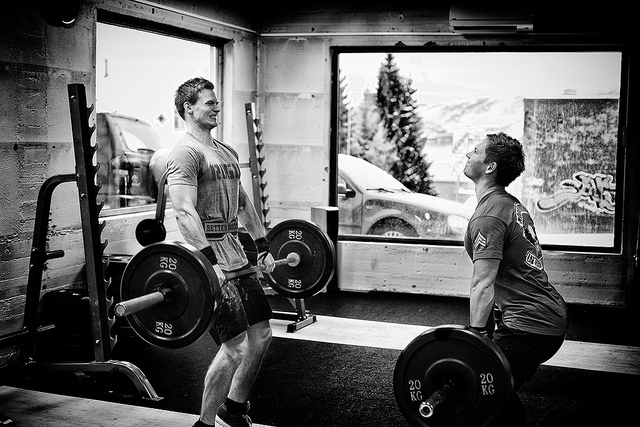
Lifting weights is dangerous. And so is Crossfit. Crossfit is dangerous.
And you know what’s really dangerous? When weak, deconditioned, imbalanced, or otherwise unhealthy people try to lift weights that are too heavy for them with poor technique, poor programming, and poor recovery, among other things (like these poor saps). That’s really dangerous. Not like stepping in front of a moving train, dangerous, but you might throw your back out and possibly end up in the hospital and/or debilitated for a really long time dangerous. No joke.
How’s that for an inflammatory intro? I can hear the trolls forming ranks in the distance.
But while we’re at it, why not mention martial arts, skiing, and mountain climbing, which are all dangerous fitness activities, too. I mean, obviously, you could get all messed up in the ring or the octagon. I’m not just talking cuts and bruises, but broken bones, concussions, or worse. And hey, one wrong step on a mountain hike or a simple skiing accident and suddenly you’re at risk of dying from exposure. Dying. Death. No mañana.
And don’t even get me started on how dangerous being a runner is. Oh, my GOSH! That’s a ridiculously high risk pastime with 50-90% of runners getting injured depending on which statistics you look at – from running of all things!
And I haven’t even mentioned the so-called extreme sports like rock climbing, hang gliding, bull riding, bungee jumping, and sky diving, among others.
But do you know what’s even more dangerous than all of these things?
Being weak. Being weak is very dangerous. So is being unhealthy, overweight, eating poorly, chronic sleep deprivation or excessive sedentary behavior. Those are all very dangerous things that affect most people – not just a fringe minority like extreme sports enthusiasts.
Now, I didn’t look up the statistics to prove this, but you and I are a heck-of-a-lot more likely to die from heart disease, cancer, or another mostly preventable lifestyle disease than from dropping a barbell on our head’s or experiencing rhabdomyolysis after a tough met-con workout – or some other freak fitness accident.
I’m just saying.
So, while I’ve never been shy to point out the risks of weightlifting, Crossfit, and running, among others, let’s try to keep some perspective here. Because even though I won’t hesitate for a second to inform you that Crossfit-style kipping pull-ups are a high-risk exercise and that I recommend most people avoid them entirely, you’re probably much safer performing them during your workout than pitching a baseball game. Or, I don’t know, going for a long drive in a car.
I mean, you’re probably just as likely to die from being struck by lightning or getting eaten by a shark as you are from lifting weights. And you’re much more likely to die from a driving accident, especially if you’re on a motorcycle, than from a high intensity Crossfit WOD. So, let’s get back to that thing we call perspective again.
Because you know what? Life is dangerous. And that’s a fact. So, I’m going to keep training, albeit properly – with none of that unhealthy, reckless nonsense that gets people hurt like clockwork – but healthy, effective, and sustainable methods that work (regardless of how trendy it is).
Something we need to remember is that both risk and danger can be greatly managed in training, and they should be! Good coaches, trainers, clients, and athletes do this day in and day out. And that’s why they’re good. That’s why they succeed in the short and long term. Now, that doesn’t mean that accidents never happen, but it’s much more rare for the person who trains smart (e.g. like using health-first fitness).
On the flip side, the people who do not manage risk and danger very well – whatever form it takes (e.g. training too heavy, too hard, too often, too long, too fast, too soon, too varied, too specified, too whatever) – they’re the ones who experience nagging pains, constantly have to work around recurring injuries, spend extra time and money on doctors and other medical professionals, take more unexpected trips to the hospital, etc. They’re the ones sitting on the sidelines – waiting for things to change – and being a spectator of their life instead of a go-getter. They’re the ones who in their 30’s, 40’s, or 50’s become the “has-beens” who talk about the “good ol’ days” back when they were fit and healthy. Now, I don’t know about you, but when I’m in my 40’s and 50s, I don’t want to just be talking. I want to be training – and properly!
So, that’s what I’m going to keep doing, and it’s what I recommend you do, too – if you’re not already. Because the healthier, stronger, and fitter you are – assuming you’re doing it right – the tougher and harder to kill you become, especially from the most common killers like heart disease, cancer, etc. And you know what? That makes YOU dangerous. Now, I don’t know about you, but I kinda like that.
If you found this article helpful, please share it with your friends:
.jpg)
![]()
Health-First Fitness Coach
P.S. If you liked this post, then please signup for the newsletter, or follow me on Facebook or Twitter for daily updates and other interesting info.
Note: Hat tip goes to Bret Contreras who inspired this post when he said, “If you think lifting weights is dangerous, try being weak. Being weak is dangerous.” Good one, Bret!